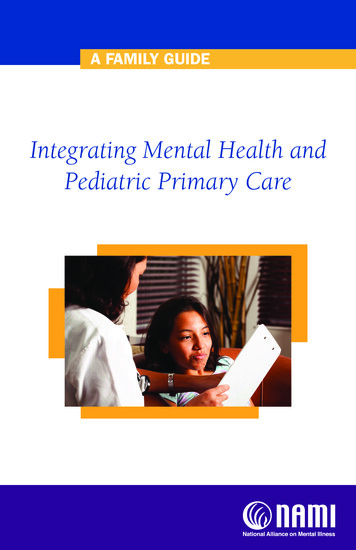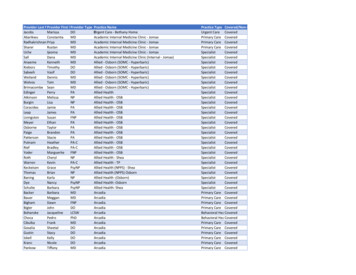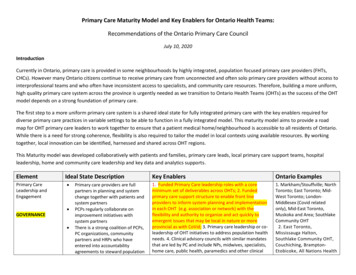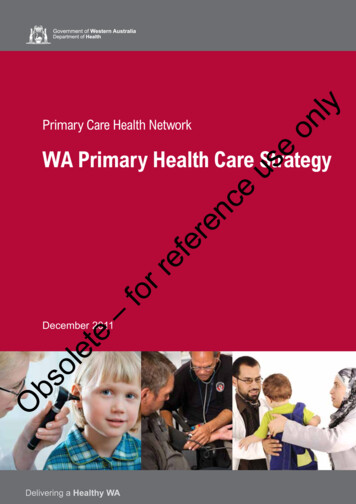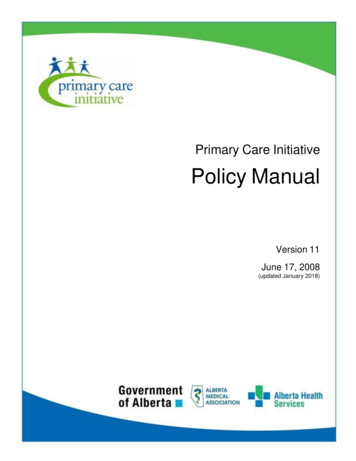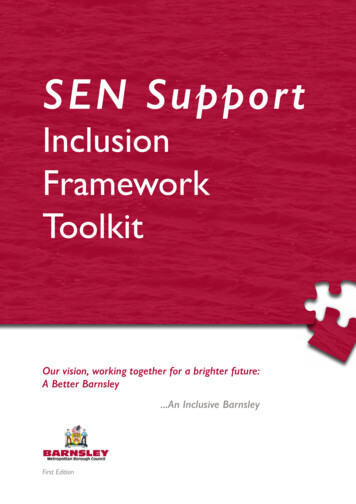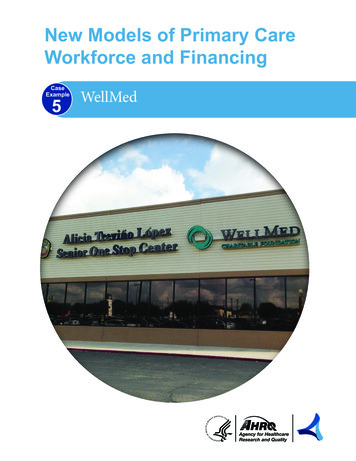
Transcription
New Models of Primary CareWorkforce and FinancingCaseExample5WellMed
New Models of Primary Care Workforceand FinancingCase Example #5: WellMedPrepared for:Agency for Healthcare Research and QualityU.S. Department of Health and Human Services5600 Fishers LaneRockville, MD 20857www.ahrq.govContract No. HHSA290-2010-00004IPrism Order No. HHSA29032009TTask Order 9Prepared by:Abt AssociatesCambridge, MassachusettsIn partnership withMacColl Center for Health Care InnovationBailit Health PurchasingAHRQ Publication No. 16(17)-0046-5-EFOctober 2016
This report is based on research conducted by Abt Associates in partnership with the MacCollCenter for Health Care Innovation and Bailit Health Purchasing, Cambridge, MA, under contractto the Agency for Healthcare Research and Quality (AHRQ), Rockville, MD (Contract Nos. 2902010-00004-I/ 290-32009-T). The findings and conclusions in this document are those of theauthors, who are responsible for its contents; the findings and conclusions do not necessarilyrepresent the views of AHRQ. Therefore, no statement in this report should be construed as anofficial position of AHRQ or of the U.S. Department of Health and Human Services.Suggested citation: New Models of Primary Care Workforce and Financing Case Example #5:WellMed. (Prepared by Abt Associates, in partnership with the MacColl Center for Health CareInnovation and Bailit Health Purchasing, Cambridge, MA, under Contract No.290-2010-00004-I/290-32009-T.) AHRQ Publication No. 16(17)-0046-5-EF. Rockville, MD: Agency forHealthcare Research and Quality; October 2016. pg. i
Table of ContentsIntroduction .1Why WellMed?.1Overview of the Practice .1Patient Population Description and Practice Panel Size .2Model of Care .2Workforce Configuration.4Care Coordination and Transitions .6Care Management .7Pharmacy Integration .8Behavioral Health Integration .8Palliative Care .8Workflow .10Team Building and Training .12Access, Comprehensiveness, and Quality .12Access .12Comprehensiveness.12Quality.13Implications for Primary Care Staffing Models .15Acknowledgements .15 pg. ii
IntroductionThe Agency for Healthcare Research and Quality (AHRQ) contracted with Abt Associates andits partners, the MacColl Center for Health Care Innovation and Bailit Health Purchasing, toconduct research on innovative ways to configure primary care workforce teams that can deliverfully comprehensive, high-quality care to the U.S. population. The purpose of the research is tooffer models of primary care teams and the associated costs for consideration and discussion bypolicymakers and providers in the field of health services delivery. To explore existinginnovative workforce configurations, AHRQ and the Abt project team conducted a literaturereview, explored extant data sources, convened a Technical Expert Workgroup of nationalexperts in primary care workforce, and conducted site visits to primary care practices withinnovative workforce configurations.The case example report that follows provides an in-depth look at the workforce configuration ofWellMed, a health care delivery network serving primarily Medicare-eligible seniors. This sitevisit included visits to a WellMed clinic: WellMed at Medical Center (located 7622 LouisPasteur Dr., Suite 100, San Antonio, TX 78229); Specialists for Health-Cardiology at MedicalCenter (located at 4330 Medical Dr., Suite 500, San Antonio, TX 78229); WellMedHeadquarters (located at 8637 Fredericksburg, Ste. 100, San Antonio, TX 78240); a new seniorclinic, WellMed at Crockett Park (located at 1715 McCullough Ave., San Antonio, TX 78212);and the Trevino Lopez Senior Center (located at 8353 Culebra Rd., San Antonio, TX 78251).Team members visited the practice on September 16–17, 2015. The data discussed below werecollected on or prior to the visit and reflect calendar year 2014.Why WellMed?WellMed is a large and growing integrated ambulatory care system with a well-establishedmodel of care that has been implemented across Central Texas and in Florida. WellMed assumesrisk for all of its Medicare Advantage patients and, using the flexibility of capitated payment, hascrafted a suite of primary care and specialty services designed to meet the needs of theirpopulation with minimal referral outside the system. Although the system does not specificallyseek patient-centered medical home recognition, its primary care practices are team based, withenhanced roles for all staff. It aspires to “one-stop shopping” for patients, bringing in-housespecialists to the primary care clinics and providing onsite lab and imaging services andbehavioral health. WellMed is embedded in the community and partners with local and Stateagencies to provide health and social services at all senior centers in the San Antonio area and tospread this model to other locations.Overview of the PracticeWellMed was founded in San Antonio in 1990 by George M. Rapier, MD, with the goal ofchanging health care delivery for seniors. His vision was to provide quality, proactive, preventivecare and build strong patient relationships. The stated mission of WellMed is to “help the sickbecome well and to help patients understand and control their health in a lifelong effort at pg. 1
wellness.” WellMed has more than 800 primary care locations in Texas and Florida, more than85 of which have integrated specialist services. Over 6,000 providers in the WellMed systemprovide services in dermatology, geriatrics, cardiology, family practice, hospital medicine,internal medicine, neurology, osteopathy, palliative care, pain management, podiatry,rheumatology, and wound care. The system runs ambulatory care practices and senior carecenters.WellMed highlights its leadership in medical risk management, effective disease managementand chronic care programs, and specializes in the complete coordination of care for patients. Thesystem is growth oriented, with a strong acquisitions team. WellMed promotes its services toprospective patients as providers who can spend time with patients, offer affordable care, andconnect qualified patients with State and Federal social and financial assistance programs.Patient Population Description and Practice Panel SizeWellMed serves more than 200,000 people in the San Antonio area who receive coverage fromMedicare Advantage. WellMed flourishes in the San Antonio market in part because SanAntonio does not have many secondary insurance coverage options. Most people have onlytraditional Medicare, and WellMed can provide much more comprehensive care than standardfee-for-service Medicare, which allows very fragmented access to specialty care.The WellMed standard for a panel is 600 capitated patients, although some physicians havemany more. Historically, physicians were paid without consideration of panel size; now thebonus policy is tied to the number of patients in the panel. New patients typically choose theirprovider, so panels are not assigned, but grow. Patient panels in WellMed primary care practicesare primarily Secure Horizons Medicare Advantage beneficiaries for whom WellMed assumesfull risk. WellMed has two categories of fee-for-service patients on panels: a small number ofpatients retained in provider panels when their practice was acquired, and WellMed employeeswho receive primary care at WellMed clinics. Approximately 90 percent of the panel of Dr.Nahim Pearose, the physician whose practice was the focus for the site visit, is capitated and 10percent are commercial patients. Dr. Pearose's current panel is approximately 400 SecureHorizons patients. He estimated 60 commercial patients. Dr. Pearose sees an average of 10–13patients per day, spending an average of 15 minutes of a total 30-minute visit with each patient.The combined total number of patients for the 2.8 FTE providers at the Medical Center clinic is2,200, comprising 1,970 Medicare Advantage patients and 250 with commercial insurance.Model of CareThe WellMed new patient brochure describes the care model as including: Access to care & information Health care for all After-hours access coverage Accessible patient & lab information pg. 2
Practice-based services Comprehensive care for both acute & chronic conditions Prevention screening & services Ancillary diagnostic services Care management Wellness promotion Disease prevention Patient engagement and education Care coordination Collaborative relationships—ER, hospital care & specialist care Care transition Practice management Disciplined financial management Cost-benefit decisionmaking Facilities management Health information technology Electronic medical record Electronic orders & reporting Evidence-based decision support Quality & DataRAPS Evidence-based best practices Medication management Quality improvement Practice-based care team Provider leadershipEffective communicationPatient participationHealth coaches pg. 3
Workforce ConfigurationExhibit 1: WellMed at Medical Center Clinic team FTEs and rolesFTE2.8Workforce Category/RoleMDsCommentsFive physicians: 2 full-time, 1 part-time (0.5), 1who works one morning session per week (0.1),and 1 who works one day per week (0.2).1.01.0PAScribe2.0LVN health coach2.0LVN8.0MA1.0X-ray technician1.0PhlebotomistFTE3.0Business Operations SupportWorkforce Category/RoleClinic managerAdministrative staff person exclusivelydedicated to insurance verificationITHousekeeping, security, maintenanceFront Office Support WorkforceCategory/RoleFront desk staffOne full-time PA.Two part-time medical students for 1.0 FTE whoscribe for Dr. McCarroll.Two full-time health coaches support one pod(three providers) each.Two full time LVNs (aside from the two healthcoaches) perform triage for incoming calls andwalk-ins.Seven full-time MAs are dedicated to specificpods. Two full-time float MAs act as triage nurses,filling in as needed. One full-time ancillary MAperforms additional MA tasks for all pods asneeded. A full-time team lead is the back-up clinicmanager as needed. The team lead has MAtraining and helps with MA tasks such asmaintaining daily flow logs, and ensuring theprocedure room is clean.One full time x-ray technician performs onsitescans.One full-time phlebotomist works onsiteperforming blood draws, sending them foranalysis, and conducting other phlebotomy tasksas needed.Comments1.02.0Call Center/OperatorMedical records clerks1.01.0XXFTEOne full-time clinic manager.Role contributed/managed centrally.Role contributed/managed centrally.CommentsThree full-time staff schedule appointments andregister/check-in/check-out patients.Two full-time clerks pull medical records and enterdata as needed and scan all paper charts into theeClinicalWorks EHR.MD medical doctor; PA physician assistant; LVN licensed vocational nurse; MA medical assistant; IT informationtechnology; LVN licensed vocational nurse; MA medical assistant; EHR electronic health record; X No specific FTEprovided/role may be paid for and managed centrallyThe WellMed at Medical Center clinic is one of 84 WellMed clinics in the San Antonio area andserves a primarily geriatric, Medicare-eligible population. The clinic has had almost no staffturnover in over 4 years. The clinic manager said that staff longevity means the clinic teams pg. 4
work well together, trust each other’s judgment, and communicate openly and consistently.Along with exam rooms and a reception area, the clinic has onsite x-ray and lab services, and aroom for minor procedures.Primary care providers (PCPs) and physician assistants (PAs) are primarily employed staff, withselected in-house specialty services as well. The clinic is divided into two “pods,” which arePCP–medical assistant (MA) teamlets with a floating MA available as needed. The two pods arephysically located on opposite sides of the clinic with MA and triage nurse desks in the center.All providers, MAs, and triage nurses can talk to each other across the center desk via anopening in the wall for quick verbal communication when needed. Teams meet daily and asneeded in huddles to plan the day’s patient schedule and review outstanding items. Each pod hasa dedicated health coach. The health coach is an integral part of the pod and works closely withpatients to establish care plans around issues such as diabetes care or weight loss. Health coachesuse motivational interviewing (MI) techniques to ensure goals set with the patient are patientdriven. The health coaches say that, because patient relationships are at the core of their work,patient-driven goals result in higher follow-through and goal achievement. The coaches followup weekly with patients to monitor progress and ensure they are making progress toward theirgoals. The health coach we interviewed normally tracks 30 followup calls per day. In addition,this coach is also a licensed vocational nurse (LVN) who acts as a backup nurse, startingintravenous medications, inserting catheters, helping with medical records, and performing otherclinical tasks as needed. Although medical issues are the core of the health coaches’ training,they regularly field requests about psychosocial needs and liaise with WellMed behavioral healthservices and social work. The health coach we interviewed mentioned that older patients mayturn to a health coach they feel comfortable with for mental health needs related to depressioncaused by loss (for example of a spouse or personal health), mental decline, or other issues. Shesaid many Latino or Asian patients are culturally inclined to simply agree with the provider as aperson of authority, but may feel more comfortable being open about personal health informationwhen meeting with the health coach. In this role, the health coach is alerted early to potentialphysical or mental health issues and has a broad understanding of the patient’s current healthissues. The coach can share this information with the larger care team (PCP, MA, behavioralhealth provider, etc.), who can tailor care appropriately.WellMed employs one or two health coaches at each clinic. Clinic coaches have monthlymeetings with the larger health coach group and monthly meetings to enhance skills, such as MItechniques. Due to the success of the onsite health coaches, the Medical Center clinicaccomplishes most diabetes coaching in-house. The health coaches are also part of the practicemanager’s core group that works on process improvement and takes the lead on clinic-specificissues.Mary Hopkins, the practice manager of the WellMed at Medical Center clinic, oversees allworkforce issues, clinic-specific strategy planning, staffing, and physical space needs. She isassisted by a team lead who was trained as an MA and is the backup clinic manager. Mary iscommitted to the idea of “backups for her backups” and encourages crosstraining as appropriate pg. 5
for licensure. She believes that when staff support each other and feel supported, they do theirjobs more effectively, efficiently, and compassionately. Mary says she works hard to addressissues in real time and doesn’t hesitate to call a quick meeting or follow up with staff on the spotto address issues or concerns. Mary said that patient care comes first, and staff members areencouraged by Dr. McCarroll, a clinical lead, and by the supervisory staff to respect each other.“It doesn’t say Dr. McCarroll on the outside of the building, it says WellMed. It’s aboutthe patient.”– Mary Hopkins, Clinic ManagerCare Coordination and TransitionsCentralized elements of the WellMed system, such as its care management program, palliativecare, and employed hospitalists in local inpatient facilities, are connected to primary care bystructural ties. These ties include dedicated care managers and hospitalists for each clinic whodevelop relationships with staff and patients. Primary care and specialist physicians attendcommon grand rounds so information and strategies can be shared. Hospitalists and otherspecialists are culturally and financially incentivized to communicate with PCPs. Messagesamong primary care teams, centralized care management staff, and specialist providers aretracked in the electronic health record (EHR) and at Patient Care Committee (PCC) meetings.Physicians are incentivized to track and intervene with high-risk patients to keep readmissionrates low, and at a minimum to communicate well through the PCC meetings.The WellMed PCC meeting, held weekly at each clinic, reviews care for all patients who: 1) arecurrently hospitalized, 2) were recently discharged from the hospital, or 3) made an emergencyroom (ER) visit. The clinic manager, physicians, PA, and health coaches all attend this meeting.Care managers, referral coordinators, and palliative care physicians assigned to the clinic fromWellMed central services also attend in person. Hospitalists for hospitalized patients call in.Physicians or hospitalists for hospitalized patients present cases, establish care plans, anticipateproblems, and plan follow-up services. Meetings use a transition or ER tracking sheet, preparedby utilization management for the organization that lists all patients from the clinic in the reviewcategories. The PCC team assigns or adjusts the risk level of each patient, based on clinicalparameters. The team may assess caregiver support and home environment, suggesting homevisits or considering referral to palliative care or other services, depending on the circumstances.The meetings are designed to keep all providers current so they can work as a team and can assistother PCPs' patients.In the Medical Center clinic, care is coordinated through the nurse triage hub that is physicallylocated in the center of the clinic and through the collaborating health coaches. Triage LVNsreceive emails and telephone calls from patients requesting care. The triage nurse sends therequest to a PCP, usually the PA, who reviews items entered by the triage nurse and decideswhether the patient requires an in-person visit, a referral to a specialist, laboratory tests, orupdated medications. The PA can also perform other provider-level actions. Decisions areusually 20 minutes from item entry. Health coaches also directly coordinate patient care pg. 6
through greater WellMed and a non-WellMed network of specialists and community resources.Health coaches regularly address behavioral health issues with patients and refer directly toWellMed social workers and behavioral health specialists. Community resources include theTexas Department of Aging and Disability, and Project MEND, which provides medicalequipment at no charge or reduced cost.Care ManagementWellMed patients have access to multiple specialty care options within WellMed and toconsultative specialty providers outside the system when indicated. Registered nurse (RN)outpatient case managers oversee the management of high-risk patients with multiple chronicconditions based on their risk stratification scores. The case managers also oversee patients in thehospital in collaboration with hospitalists and health coaches. These RNs set up followupappointments with specialists, determine barriers to discharge, and work with social serviceagencies to provide services. Transition care followup is typically 30 days.Complex patients receive services from an RN outpatient case manager assigned to the patient'sprimary care team. This RN conducts home visits to ensure the patient is taking the appropriatemedications, assess symptoms, and perform other tasks. Complex patients may be referred tocare management by their PCP, who can request a home visit to determine complexity and theadequacy and safety of their home environment. An assessment determines followup frequency.All patients in a particularly high-risk stratification category receive in-home visits, with the caremanager sending regular reports to and communicating with the PCP. In-hospital care managersrefer complex patients to outpatient care management. Both in-hospital and outpatient casemanagers attend Medical Center PCC meetings, either in person or on the phone. Complex carefollowup is traditionally for 90 days before the patient is returned to the primary care team. Thepatient’s willingness to accept services also determines followup and interactions.WellMed is currently conducting a telemedicine pilot with RN case managers who install scales,blood pressure measurement devices, and pulse oximetry equipment in patient homes. To reporttheir health remotely, patients answer five computer-generated “yes/no” questions (in English orSpanish). Alerts generated by “no” answers or out-of-range clinical measurements are relayed tocentralized telemedicine RNs, who alert care management.WellMed has no specific protocols for specialty referrals to avoid creating barriers to referral andeducates PCPs on algorithms for care. Commonly used specialty physicians such as cardiologistshave specific office hours in primary care clinics and frequently see patients together with thePCP. WellMed has far fewer specialists than other systems: for instance, they have noendocrinologists. WellMed is starting to focus on the culture of care between primary andspecialty care with the goal of helping both groups understand they are on the same team andrealize the importance of collaborating with the right people. pg. 7
Pharmacy IntegrationWellMed addresses medication management for geriatric populations by conducting medicationreconciliation at every primary care and specialty visit. Patients are asked to bring all theirmedications with them to every visit. WellMed is developing a partnership with the University ofthe Incarnate Word to collaborate on integrated pharmacy care delivery.Behavioral Health IntegrationBehavioral health services at the Medical Center clinic are provided 4 hours per week by apsychiatrist supplied by Zeitgeist, a local mental health organization. Services are medicationmanagement for mental illness (including major depression), and behavioral modificationtherapy. The Medical Center clinic also partners with a local behavioral health training program.For a 5 flat fee, clinicians in training will see any WellMed patient for individual and familycounseling, behavioral health, and cognitive behavior therapy.Palliative CarePalliative care is an integral part of primary care for geriatric populations at WellMed. Unlikehospice, palliative care still provides primary care, while focusing on comfort. Dr. ElizabethGlazier started the palliative care program at WellMed as a subspecialty consultation service,offering expertise on palliative care issues to PCPs and care managers. The program now has amultidisciplinary care team that provides home visits and on-call services 24/7.Any WellMed member is eligible for palliative care services at no out-of-pocket expense.Patients are referred to the program either directly by their PCP or via a palliative care teamrepresentative who regularly attends the PCC at their PCP clinic. Patients can be seen in clinic orin the home. Patients seen at home, who are the most ill, are often admitted into the Bridgeshome visiting program within palliative care. Patients retain their PCP, who is included in alldecisions to maintain continuity of care. The Bridges team also uses the eClinicalWorks EHRand advises the PCP about all decisions and updates.Psychosocial issues are primarily addressed by social workers on the palliative care team, whoalso train WellMed RNs, MAs, LVNs, and nurse practitioners in relevant skills. The entirepalliative care team performs home visits. Some homebound patients need advanced clinicalcare, so the team says it creates “a clinic without walls.” The team also notes food and householdneeds, facilitates as-needed behavior change and home modifications, and supports the caregiver.The palliative care team interfaces with WellMed PCPs about care issues, end-of-life plans, andchanges in care goals to balance guideline-driven care and what is preferred by the patient. Thepalliative care program refers to hospice and works with many hospices in San Antonio; none arepart of WellMed. Hospice provides services such as 24/7 nurses who respond in home, achaplain, and in-home bathing. The palliative care team says it is proud that 90 percent ofpatients in the program die at home with family near. This far exceeds the national average fordying at home, which is a general patient preference, and also avoids the high cost of a terminalhospital stay. The team is figuring out how best to prevent patients from final, unnecessary pg. 8
hospitalizations and are encouraging earlier referral to palliative care. The WellMed palliativecare service initiated a “Call us first” campaign with a refrigerator magnet encouraging patientsto call them first and not 911. They educate about the services they provide, such as intravenousfluids, x-rays, advice, and reassurance about disturbing symptoms. The program is resulting infewer catastrophic high cost cases that end with patients dying in intensive care units. Theprogram is a financial benefit for the system, but Dr. Glazier also believes it creates a muchbetter quality end-of-life experience for patients.Dr. Glazier is a proponent of the palliative care model as a way for geriatric patients to age inplace. She gives regular grand rounds presentations and is developing an algorithm or protocol tohelp PCPs understand when to refer to palliative care. She would like to take this protocolnationwide to share with other Medicare advantage programs and is developing a “palliative carein a box” starter kit for this purpose.WellMed Palliative Care Staffing Model (provided by WellMed) pg. 9
WorkflowAt the WellMed at Medical Center clinic, the front desk staff use a color-coding system forpatient charts. For example, patients who received reminder calls about upcoming appointmentshave lavender flags in their chart. Front desk and medical records staff and the x-ray techniciandivide the task of calling patients to remind them of appointments. Outstanding issues areidentified during the reminder call or when the patient arrives. To prepare for a patient visit, anMA reviews the patient’s record before the visit and discusses issues or concerns with the PCP inthe daily huddle. The front desk staff greets the patient on arrival and marks the patient’s chart totell the MA that the patient has arrived and has been checked in.Workflow at the Medical Center clinic follows many common clinic workflow procedures with afew notable exceptions. To directly engage and emphasize the patient-first mission, patients areapproached in-person by the MA in the waiting room. To assist with recognition, patients arephotographed when they come for their first visit.Once patients have checked in, MAs record weight and vitals and talk with patients to put themat ease. MAs also review reasons for patient visits and medications, and check for standard wellcare such as last colonoscopy or mammogram and other preventive care if applicable. Iflaboratory tests are needed or vaccines are due, this is noted in the electronic record as part ofpatient followup. MAs then check with the PCP to confirm ordering of necessary tests. MAsleave while the PCP performs the visit and addresses the reason for the visit. The PCP entersmedical information into the EHR in real time. Visits often take 30 minutes because of theneeds of the geriatric population. Once the PCP part of the visit is complete, the MA returns todeliver vaccines or escort the patient to the laboratory or x-ray if needed. Followup visits, ifnecessary, are scheduled at the front desk before the patient leaves. Referral or followupinformation is relayed to the patient again by the front desk staff. Some patients receive followupcalls directly from the health care coach or the PCP, depending on their care plan.Physician ScribesOne physician at the Medical Center clinic uses a scribe for documenting visits; this is a gr
WellMed serves more than 200,000 people in the San Antonio area who receive coverage from Medicare Advantage. WellMed flourishes in the San Antonio market in part because San Antonio does not have many secondary insurance coverage options. Most people have only traditional Medicare, and WellMed can provide much more comprehensive care than standard
